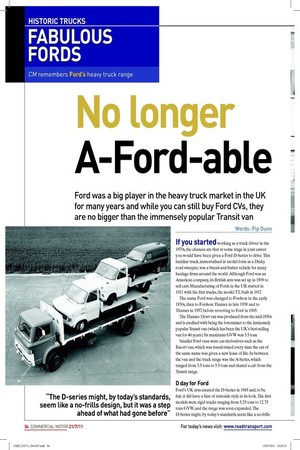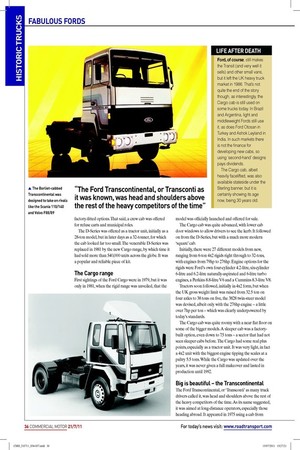No longer A-Ford-able
Page 29

Page 30

Page 31

Page 32

If you've noticed an error in this article please click here to report it so we can fix it.
Ford was a big player in the heavy truck market in the UK for many years and while you can still buy Ford CVs, they are no bigger than the immensely popular Transit van
Words: Pip Dunn If you started working as a truck driver in the 1970s, the chances are that at some stage in your career you would have been given a Ford D-Series to drive. This familiar truck, immortalised in model form as a Dinky road sweeper, was a bread-and-butter vehicle for many haulage irms around the world. Although Ford was an American company, its British arm was set up in 1909 to sell cars. Manufacturing of Fords in the UK started in 1911 with the irst trucks, the model TT, built in 1917.
The name Ford was changed to Fordson in the early 1930s, then to Fordson Thames in late 1939 and to Thames in 1957, before reverting to Ford in 1965.
The Thames 15cwt van was produced from the mid-1950s and is credited with being the forerunner to the immensely popular Transit van (which has been the UK’s best-selling van for 46 years). Its maximum GVW was 3.5 tons.
Smaller Ford vans were car-derivatives such as the Escort van, which was transformed every time the car of the same name was given a new lease of life. In between the van and the truck range was the A-Series, which ranged from 3.5 tons to 5.5 tons and shared a cab from the Transit range.
D day for Ford
Ford’s UK arm created the D-Series in 1965 and, to be fair, it did have a hint of stateside style in its look. The irst models were rigid trucks ranging from 5.25 tons to 12.75 tons GVW, and the range was soon expanded. The D-Series might, by today’s standards, seem like a no-frills design, but when it was introduced it was a step ahead of what had gone before it – the Thames Trader. The irst models had a tilt cab to cover the Cummins 7.7-litre V8 diesel engine, although the engine range was soon broadened to suit operators’ needs. Heavier trucks were added to the portfolio to appeal to tipper men and those wishing to exploit the increase in weights and growth of road haulage as it won trafic from the railways.
When the D-Series was devised, sleeper cabs were a rarity, and the day cab was the only option. In later days a few Ds would have sleeper conversions, but there were no factory-itted options. That said, a crew cab was offered for refuse carts and municipal roles.
The D-Series was offered as a tractor unit, initially as a 28-ton model, but in later days as a 32-tonner, for which the cab looked far too small. The venerable D-Series was replaced in 1981 by the new Cargo range, by which time it had sold more than 540,000 units across the globe. It was a popular and reliable piece of kit.
The Cargo range
First sightings of the Ford Cargo were in 1979, but it was only in 1981, when the rigid range was unveiled, that the model was oficially launched and offered for sale.
The Cargo cab was quite advanced, with lower cab door windows to allow drivers to see the kerb. It followed on from the D-Series, but with a much more modern ‘square’ cab.
Initially, there were 27 different models from new, ranging from 6-ton 4x2 rigids right through to 32-tons, with engines from 79hp to 276hp. Engine options for the rigids were Ford’s own four-cylinder 4.2-litre, six-cylinder 6-litre and 6.2-litre naturally-aspirated and 6-litre turbo engines, a Perkins 8.8-litre V6 and a Cummins 8.3-litre V8.
Tractors soon followed, initially in 4x2 form, but when the UK gross weight limit was raised from 32.5 ton on four axles to 38 tons on ive, the 3828 twin-steer model was devised, albeit only with the 276hp engine – a little over 7hp per ton – which was clearly underpowered by today’s standards.
The Cargo cab was quite roomy with a near lat loor on some of the bigger models. A sleeper cab was a factorybuilt option, even down to 7.5 tons – a sector that had not seen sleeper cabs before. The Cargo had some real plus points, especially as a tractor unit. It was very light, in fact a 4x2 unit with the biggest engine tipping the scales at a paltry 5.5 tons. While the Cargo was updated over the years, it was never given a full makeover and lasted in production until 1992.
Big is beautiful – the Transcontinental
The Ford Transcontinental, or ‘Transconti’ as many truck drivers called it, was head and shoulders above the rest of the heavy competitors of the time. As its name suggested, it was aimed at long-distance operators, especially those heading abroad. It appeared in 1975 using a cab from French builder Berliet and was designed to compete with, among others, Scania’s 110/140, Volvo’s F88/89, DAF’s 2800 and Mercedes’ 1626/32. It was to be Ford’s key to big orders in Europe.
The big Ford was developed to meet planned rises in GVWs, but as these did not happen immediately within the UK, it was, for most British applications at 32 tons, way too heavy.
With 14-litre Cummins engines, ranging from a basic 250hp through to a powerful 350hp (this was 1975 remember), the Transconti was an impressive piece of kit. It was offered as a 4x2 and 6x4 tractor, and a 4x2, 6x2 and 6x4 rigid for drawbar use. The only cab option was a sleeper. Eaton gearboxes were used, so the vehicle was essentially a kit of parts using components bought in from other manufacturers.
Ironically, the Transcontinental lasted until 1983 – the year the heavier 38 tons GVW was agreed – but there was to be no reprieve and, whereas the D-Series had been replaced, Ford’s big long-distance truck wasn’t. Reliability was an issue, but with a production run of just under 9,000 units – most of which were built in Amsterdam with about 500 built by Foden under licence in Sandbach – it was not cost-effective in terms of research and development to design and build a replacement.
Despite its voluminous cab, by the time of its demise, sales suggested it simply wasn’t a match for Volvo’s F10/12, Scania’s R142 or even DAF’s 3600, and sales declined suficiently to pull the plug on the production line, which could be better used making Cargo trucks.
Iveco takes over
In 1986 Ford sold its European heavy truck range to Iveco and while the Cargo remained in production – still with a Ford badge on it, from then on the writing was on the wall.
In 1993 the Eurocargo was born. It was an Iveco product, and while the Ford badge was retained on the new trucks, and indeed the heavier Eurotech and Eurostar models, it was placed out of the way down the bottom of the grille, akin to a small pimple on the chin! In 2003 the Ford name was dropped from Iveco’s range. ■














































